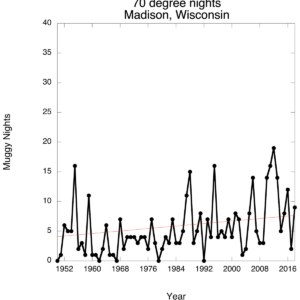A curious feature of the warming climate is that Wisconsin has not been experiencing more hot days. In fact, most places around the state show a declining trend during recent decades. At the same time, however, the frequency of extremely warm nights has been increasing, as evidenced by the trends in hot days (daytime high temperatures of 90 degrees or higher) and muggy nights (low temperatures of at least 70 degrees ) since the mid-20th century in Madison.
(Click thumbnails to view larger images)
These diverging trends reflect the changing nature of our region’s heat waves, as illustrated in the graphs below, which depict the annual difference between hot days and muggy nights. Madison has experienced a pronounced shift over time between extreme heat occurring much more during the day several decades ago toward a near balance between day and night in recent years.
For example, at the beginning of the record in 1950, extreme daytime heat occurrences exceeded extreme nighttime heat events by about two weeks per year. By now, though, that difference has completely disappeared and has even reversed a bit (slightly more common extreme nighttime heat at the end of the record). The same story, albeit less pronounced, is true statewide, based on the average of Madison and five other primary weather stations across Wisconsin: Milwaukee, La Crosse, Eau Claire, Wausau, and Green Bay.

There may be many reasons for this change, but a likely cause is the greater amount of atmospheric moisture in our warming climate, which has been documented nationally and locally. Nighttime temperatures are very sensitive to humidity and usually don’t fall as much when the air contains a lot of water vapor. By contrast, daytime temperatures are often tempered by high humidity, due to the prevalence of haze, clouds, and precipitation.
There is evidence that humidity has been increasing not only because of the warming climate but also because of more intensive agriculture, which enhances evapotranspiration (for example, tall corn plants transpiring in tightly packed fields nowadays, compared with shorter and less packed fields many years ago). It’s also possible that some of the rising trend in nighttime temperatures is due to urbanization, since urban heat islands are more pronounced at night.
Whatever the reason(s), we know that elevated heat at night can be very problematic for health, because people have trouble recovering during heat waves when un-airconditioned homes are too hot for quality sleep. The observed shift from more extreme daytime heat toward more extreme nocturnal heat is something that should be factored into heat wave action plans, since strategies for staying cool during the day are different from those for the night.

